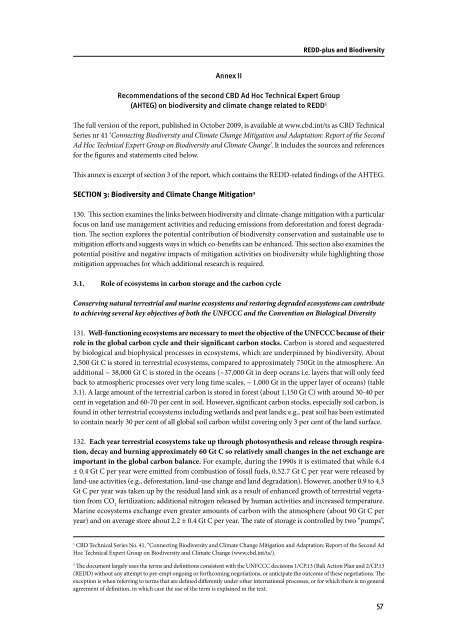REDD-plus and Biodiversity - Convention on Biological Diversity
REDD-plus and Biodiversity - Convention on Biological Diversity
REDD-plus and Biodiversity - Convention on Biological Diversity
Create successful ePaper yourself
Turn your PDF publications into a flip-book with our unique Google optimized e-Paper software.
<str<strong>on</strong>g>REDD</str<strong>on</strong>g>-<str<strong>on</strong>g>plus</str<strong>on</strong>g> <str<strong>on</strong>g>and</str<strong>on</strong>g> <str<strong>on</strong>g>Biodiversity</str<strong>on</strong>g><br />
Annex II<br />
Recommendati<strong>on</strong>s of the sec<strong>on</strong>d CBD Ad Hoc Technical Expert Group<br />
(AHTEG) <strong>on</strong> biodiversity <str<strong>on</strong>g>and</str<strong>on</strong>g> climate change related to <str<strong>on</strong>g>REDD</str<strong>on</strong>g> 1<br />
The full versi<strong>on</strong> of the report, published in October 2009, is available at www.cbd.int/ts as CBD Technical<br />
Series nr 41 ‘C<strong>on</strong>necting <str<strong>on</strong>g>Biodiversity</str<strong>on</strong>g> <str<strong>on</strong>g>and</str<strong>on</strong>g> Climate Change Mitigati<strong>on</strong> <str<strong>on</strong>g>and</str<strong>on</strong>g> Adaptati<strong>on</strong>: Report of the Sec<strong>on</strong>d<br />
Ad Hoc Technical Expert Group <strong>on</strong> <str<strong>on</strong>g>Biodiversity</str<strong>on</strong>g> <str<strong>on</strong>g>and</str<strong>on</strong>g> Climate Change’. It includes the sources <str<strong>on</strong>g>and</str<strong>on</strong>g> references<br />
for the figures <str<strong>on</strong>g>and</str<strong>on</strong>g> statements cited below.<br />
This annex is excerpt of secti<strong>on</strong> 3 of the report, which c<strong>on</strong>tains the <str<strong>on</strong>g>REDD</str<strong>on</strong>g>-related findings of the AHTEG.<br />
SECTION 3: <str<strong>on</strong>g>Biodiversity</str<strong>on</strong>g> <str<strong>on</strong>g>and</str<strong>on</strong>g> Climate Change Mitigati<strong>on</strong> 2<br />
130. This secti<strong>on</strong> examines the links between biodiversity <str<strong>on</strong>g>and</str<strong>on</strong>g> climate-change mitigati<strong>on</strong> with a particular<br />
focus <strong>on</strong> l<str<strong>on</strong>g>and</str<strong>on</strong>g> use management activities <str<strong>on</strong>g>and</str<strong>on</strong>g> reducing emissi<strong>on</strong>s from deforestati<strong>on</strong> <str<strong>on</strong>g>and</str<strong>on</strong>g> forest degradati<strong>on</strong>.<br />
The secti<strong>on</strong> explores the potential c<strong>on</strong>tributi<strong>on</strong> of biodiversity c<strong>on</strong>servati<strong>on</strong> <str<strong>on</strong>g>and</str<strong>on</strong>g> sustainable use to<br />
mitigati<strong>on</strong> efforts <str<strong>on</strong>g>and</str<strong>on</strong>g> suggests ways in which co-benefits can be enhanced. This secti<strong>on</strong> also examines the<br />
potential positive <str<strong>on</strong>g>and</str<strong>on</strong>g> negative impacts of mitigati<strong>on</strong> activities <strong>on</strong> biodiversity while highlighting those<br />
mitigati<strong>on</strong> approaches for which additi<strong>on</strong>al research is required.<br />
3.1. Role of ecosystems in carb<strong>on</strong> storage <str<strong>on</strong>g>and</str<strong>on</strong>g> the carb<strong>on</strong> cycle<br />
C<strong>on</strong>serving natural terrestrial <str<strong>on</strong>g>and</str<strong>on</strong>g> marine ecosystems <str<strong>on</strong>g>and</str<strong>on</strong>g> restoring degraded ecosystems can c<strong>on</strong>tribute<br />
to achieving several key objectives of both the UNFCCC <str<strong>on</strong>g>and</str<strong>on</strong>g> the <str<strong>on</strong>g>C<strong>on</strong>venti<strong>on</strong></str<strong>on</strong>g> <strong>on</strong> <strong>Biological</strong> <strong>Diversity</strong><br />
131. Well-functi<strong>on</strong>ing ecosystems are necessary to meet the objective of the UNFCCC because of their<br />
role in the global carb<strong>on</strong> cycle <str<strong>on</strong>g>and</str<strong>on</strong>g> their significant carb<strong>on</strong> stocks. Carb<strong>on</strong> is stored <str<strong>on</strong>g>and</str<strong>on</strong>g> sequestered<br />
by biological <str<strong>on</strong>g>and</str<strong>on</strong>g> biophysical processes in ecosystems, which are underpinned by biodiversity. About<br />
2,500 Gt C is stored in terrestrial ecosystems, compared to approximately 750Gt in the atmosphere. An<br />
additi<strong>on</strong>al ~ 38,000 Gt C is stored in the oceans (~37,000 Gt in deep oceans i.e. layers that will <strong>on</strong>ly feed<br />
back to atmospheric processes over very l<strong>on</strong>g time scales, ~ 1,000 Gt in the upper layer of oceans) (table<br />
3.1). A large amount of the terrestrial carb<strong>on</strong> is stored in forest (about 1,150 Gt C) with around 30-40 per<br />
cent in vegetati<strong>on</strong> <str<strong>on</strong>g>and</str<strong>on</strong>g> 60-70 per cent in soil. However, significant carb<strong>on</strong> stocks, especially soil carb<strong>on</strong>, is<br />
found in other terrestrial ecosystems including wetl<str<strong>on</strong>g>and</str<strong>on</strong>g>s <str<strong>on</strong>g>and</str<strong>on</strong>g> peat l<str<strong>on</strong>g>and</str<strong>on</strong>g>s; e.g., peat soil has been estimated<br />
to c<strong>on</strong>tain nearly 30 per cent of all global soil carb<strong>on</strong> whilst covering <strong>on</strong>ly 3 per cent of the l<str<strong>on</strong>g>and</str<strong>on</strong>g> surface.<br />
132. Each year terrestrial ecosystems take up through photosynthesis <str<strong>on</strong>g>and</str<strong>on</strong>g> release through respirati<strong>on</strong>,<br />
decay <str<strong>on</strong>g>and</str<strong>on</strong>g> burning approximately 60 Gt C so relatively small changes in the net exchange are<br />
important in the global carb<strong>on</strong> balance. For example, during the 1990s it is estimated that while 6.4<br />
± 0.4 Gt C per year were emitted from combusti<strong>on</strong> of fossil fuels, 0.52.7 Gt C per year were released by<br />
l<str<strong>on</strong>g>and</str<strong>on</strong>g>-use activities (e.g., deforestati<strong>on</strong>, l<str<strong>on</strong>g>and</str<strong>on</strong>g>-use change <str<strong>on</strong>g>and</str<strong>on</strong>g> l<str<strong>on</strong>g>and</str<strong>on</strong>g> degradati<strong>on</strong>). However, another 0.9 to 4.3<br />
Gt C per year was taken up by the residual l<str<strong>on</strong>g>and</str<strong>on</strong>g> sink as a result of enhanced growth of terrestrial vegetati<strong>on</strong><br />
from CO 2<br />
fertilizati<strong>on</strong>; additi<strong>on</strong>al nitrogen released by human activities <str<strong>on</strong>g>and</str<strong>on</strong>g> increased temperature.<br />
Marine ecosystems exchange even greater amounts of carb<strong>on</strong> with the atmosphere (about 90 Gt C per<br />
year) <str<strong>on</strong>g>and</str<strong>on</strong>g> <strong>on</strong> average store about 2.2 ± 0.4 Gt C per year. The rate of storage is c<strong>on</strong>trolled by two “pumps”,<br />
1<br />
CBD Technical Series No. 41, “C<strong>on</strong>necting <str<strong>on</strong>g>Biodiversity</str<strong>on</strong>g> <str<strong>on</strong>g>and</str<strong>on</strong>g> Climate Change Mitigati<strong>on</strong> <str<strong>on</strong>g>and</str<strong>on</strong>g> Adaptati<strong>on</strong>: Report of the Sec<strong>on</strong>d Ad<br />
Hoc Technical Expert Group <strong>on</strong> <str<strong>on</strong>g>Biodiversity</str<strong>on</strong>g> <str<strong>on</strong>g>and</str<strong>on</strong>g> Climate Change (www.cbd.int/ts/).<br />
2<br />
The document largely uses the terms <str<strong>on</strong>g>and</str<strong>on</strong>g> definiti<strong>on</strong>s c<strong>on</strong>sistent with the UNFCCC decisi<strong>on</strong>s 1/CP.13 (Bali Acti<strong>on</strong> Plan <str<strong>on</strong>g>and</str<strong>on</strong>g> 2/CP.13<br />
(<str<strong>on</strong>g>REDD</str<strong>on</strong>g>) without any attempt to pre-empt <strong>on</strong>going or forthcoming negotiati<strong>on</strong>s, or anticipate the outcome of these negotiati<strong>on</strong>s. The<br />
excepti<strong>on</strong> is when referring to terms that are defined differently under other internati<strong>on</strong>al processes, or for which there is no general<br />
agreement of definiti<strong>on</strong>, in which case the use of the term is explained in the text.<br />
57

















